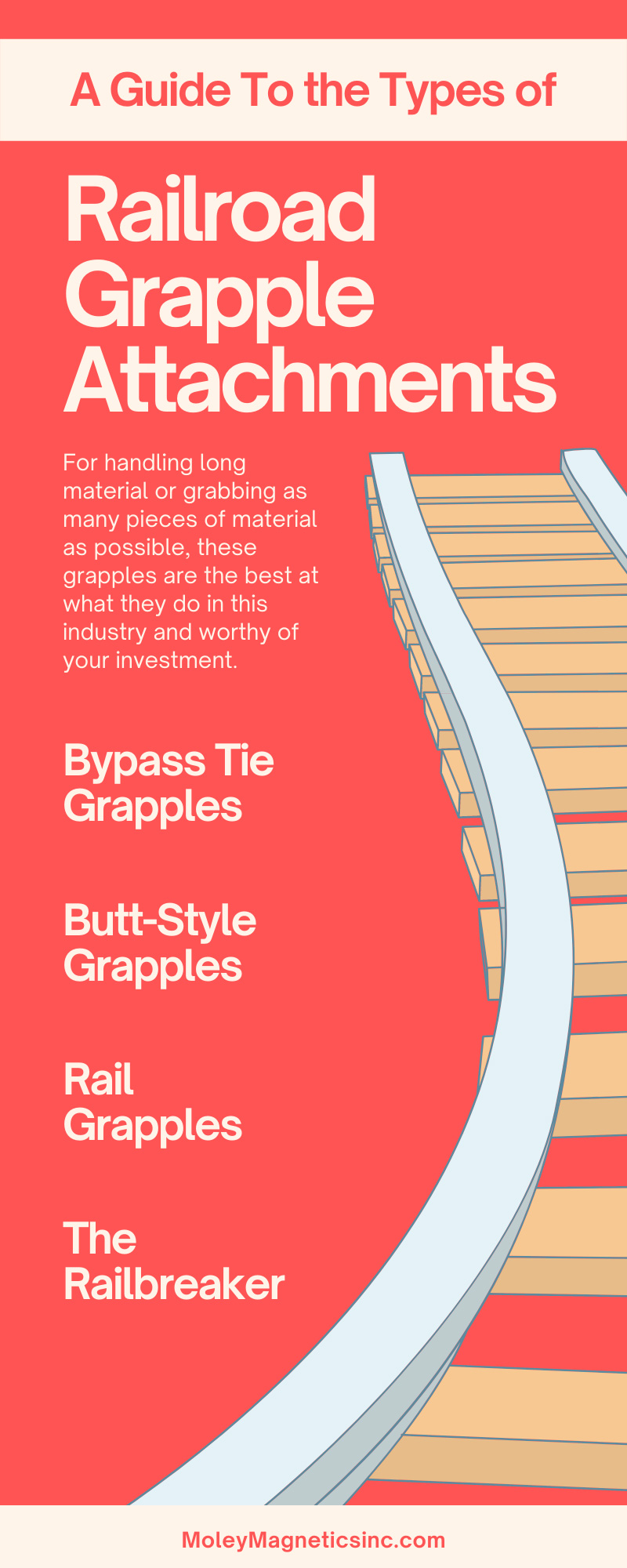
A Guide To the Types of Railroad Grapple Attachments
Lots of people have interesting hobbies. Among them is a keen enthusiasm for America’s railway system. Some observers find this passion rather strange. To the uninitiated, caring about railroads seems a bit passé. Hasn’t our society moved past trains by now?
We haven’t and we won’t. For affordable and reliable transport of key goods, there’s no better way to set them in motion than upon the miles and miles of railroad tracks that crisscross America. Airfreight is an extravagance for many industries. America’s highways are also extensive, but diesel fuel isn’t cheap, and it’s certainly not about to get any cheaper. And while expanding broadband infrastructure has been critical to the knowledge economy, there is no known way to email wheat.
The point is that our railroads are not just a bygone curiosity. They’re part of our past, present, and future. Even more to the point, as a construction firm, railroads can be part of your future. The maintenance of existing trackage and expansion to new destinations is a task that your team can take on—with the right tools, of course. Chief among these tools is your complement of railroad grapples. These tools of the trade, similar to many of the implements you’re already familiar with from the construction industry, specialize in handling the tasks and materials unique to rail work. In this guide to the types of railroad grapple attachments, we’ll walk you through a virtual showroom of the railway construction equipment you’ll find at Moley Magnetics as you hopefully develop a train interest of your own.
The Basics
A railroad, in some sense, is remarkably simple in its construction. It consists of three main parts: the rails, the ties, and the ballast upon which you place them. The ballast, typically being gravel, slag, or some other form of aggregate, is something you’ll instead want to handle with a bucket attachment. For handling rails and ties, whether picking them up to put them into place or pulling them up to remove them, you’ll want industry-specific grapples. For handling long material or grabbing as many pieces of material as possible, these grapples are the best at what they do in this industry and worthy of your investment.
Bypass Tie Grapples
Don’t let the name fool you here. This grapple isn’t skipping or getting around anything—unless you include getting around having to make additional trips to pick up ties. What’s doing the bypassing in a bypass tie grapple are its tines. In many other varieties of grapple, such as the orange peel grapple that is so popular for handling material, the tines come to a point. This is an ideal design for carrying a payload in which you need that pressure coming from both—or all four—sides to keep the material in place. In a bypass grapple, however, the tines pass by each other in a closed position, just as your fingers would if you locked your hands together. By bypassing rather than meeting, the tines act as a cradle, giving support to a large bundle of railroad ties—as many as six to eight, in some cases. It’s a much more efficient way to start putting ties into position as you lay down new trackage.
Butt-Style Grapples
While a bypass grapple represents a divergence from typical grapple construction, the butt-style grapple takes things back to basics. As is typical, both tines meet at a center point. However, a butt grapple features a pair of jaws with a wide, bowl-like design, which can help to support ties or prefabricated segments of rail as you move them into or out of position. The butt-style tie grapple from Moley Magnetics has an additional feature—you can choose between solid or grilled tines for loading and unloading track material. Solid is the usual choice, but if you’re involved in the demolition side as much as the construction side and are hoping to slough off some dirt, dust, and ballast as you lift up rails and ties, the vented design of grilled tines may be ideal.
Rail Grapples
Working not with railroad ties but with the steel rails themselves calls for a specific grapple attachment. Exactly as its name suggests, a rail grapple specializes in handling long and heavy steel rails. Whereas most grapple attachments work with a typical excavator and switch in and out of service as necessary, a rail grapple is most often a dedicated extension to a purpose-built piece of rail maintenance equipment. One is the railroad loader, a piece of heavy machinery that is similar to an excavator. Another is a rail truck, an automobile that can also work along rails for construction and maintenance purposes. Whether you attach your rail grapple to a truck crane or to a railroad loader, it’s the tool of choice for lifting long and unwieldy rails and putting them into place.
The Railbreaker
Expanding and maintaining America’s vast network of railroads isn’t all about laying down trackage where it hasn’t run before. It’s not all about preserving existing trackage. Sometimes, wear and tear are so advanced that you simply need to place new rails along an existing right-of-way, and it’s with that problem that we wind down our guide to the types of railroad grapple attachments. When it’s out with the old and in with the new, you need to figure out exactly where the old is going and how you’re going to get it there. The MB420 rail breaker from Moley Magnetics will certainly help you in that regard. Bearing a name that already sounds fearsome, the rail breaker is a specialized shear that attaches to your excavator as grapples do, taking long steel rails and cutting them down to more manageable scrap for transport to recycling facilities. The rail breaker grabs the steel track and uses incredible force to do what seems unthinkable—making short work of some of the most durable infrastructure in place.
If an expansion into railroad construction or maintenance suits your concern, Moley Magnetics has you covered with its arsenal of railroad grapple attachments, and more. As a leading railroad equipment supplier for Western New York and the Niagara Frontier, we feature grapples, buckets, magnets, generators, and everything, it would seem, but the train.


